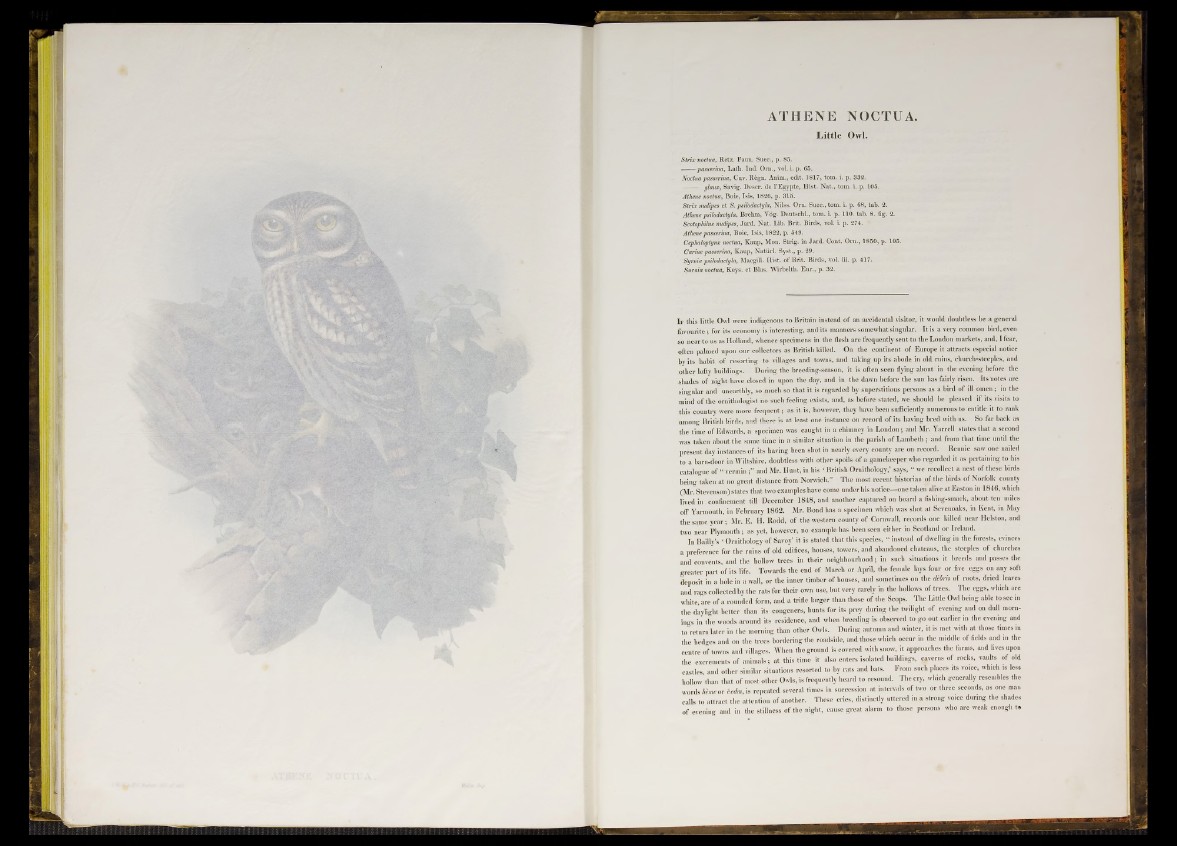
H
ATHENE NOCTUA.
Little Owl.
Strix noctua, Retz. Faun. Suec., p. 86.
passerina, Lath. Ind. Orn., vol. i. p. 65.
Noctua passerina, Cuv. Règn. Anim., edit. 1817, tom. i. p. 332.
— glaux, Savig. Descr. de l’Egypte, Hist. Nat., tom. i. p. 105.
Athene noctua, Boie, Isis, 1826, p. 315.
Strix nudipes et S. psilodactyla, Nilss. Orn. Suec., tom. i. p. 68, tab. 2.
Athene psilodactyla, Brehm, Yog. Deutschl., tom. i. p. 110. tab. 8. fig. 2.
Scotophilus nudipes, Jard. Nat. Lib. Brit. Birds, vol. i. p. 274.
Athene passerina, Boie, Isis, 1822, p. 549.
Cephaloptynx noctua, Kaup, Mon. Strig. in Jard. Cont. Orn., 1850, p. 106.
Carine passerina, Kaup, Natiirl. Syst., p. 29.
Symia psilodactyla, Macgill. Hist, of Brit. Birds, vol. iii. p. 417.
Sumia noctua, Keys, et Bias. Wirbelth. Eur., p. 32.
I f this little Owl were indigenous to Britain instead of an accidental visitor, it would doubtless be a general
favourite ; for its economy is interesting, and its manners somewhat singular. I t is a very common bird, even
so near to us as Holland, whence specimens in the flesh are frequently sent to the London markets, and, I fear,
often palmed upon our collectors as British killed. On the continent of Europe it attracts especial notice
by its habit of resorting to villages and towns, and taking up its abode in old ruins, church-steeples, and
other lofty buildings. During the breeding-season, it is often seen flying about in the evening before the
shades o f night have closed in upon the day, and in the dawn before the sun has fairly risen. Its notes are
singular and unearthly, so much so th at it is regarded by superstitious persons as a bird of ill omen; in the
mind o f the ornithologist no such feeling exists, and, as before stated, we should be pleased if its visits to
this country were more frequent; as it is, however, they have been sufficiently numerous to entitle it to rank
among British birds, and there is at least one instance on record of its having bred with us. So far back as
the time of Edwards, a specimen was caught in a chimney in London; and Mr. Yarrell states that a second
was taken about the same time in a similar situation in the parish of Lambeth ; and from that time until the
present day instances o f its having been shot in nearly every county are on record. Rennie saw one nailed
to a barn-door in Wiltshire, doubtless with other spoils o f a gamekeeper who regarded it as pertaining to his
catalogue of “ vermin and Mr. Hunt, in his ‘ British Ornithology,’ says, “ we recollect a nest of these birds
being taken a t no great distance from Norwich.” The most recent historian o f the birds of Norfolk county
(Mr. Stevenson) states that two examples have come under his notice—one taken alive at Easton in 1846, which
lived i n . confinement till December 1848, and another captured on board a fishing-smack, about ten miles
off Yarmouth, in February 1862. Mr. Bond has a specimen which was shot at Sevenoaks, in Kent, in, May
the same y e a r; Mr. E . H. Rodd, of the western county o f Cornwall, records one killed near Helston, and
two near Plymouth; as yet, however, no example has been seen either in Scotland or Ireland.
In Bailly’s ‘ Ornithology o f Savoy’ it is stated that this species, “ instead of dwelling in the forests, evinces
a preference for the ruins of old edifices, houses, towers, and abandoned chateaus, the steeples o f churches
and convents, and the hollow trees in their neighbourhood; in such situations it breeds and passes the
greater part of its life. Towards the end of March or April, the female lays four o r five eggs on any soft
deposit in a hole in a wall, or the inner timber of houses, and sometimes on the debris o f roots, dried leaves
and rags collected by the rats for their own use, but very rarely in the hollows of trees. The eggs, which are
white, are o f a rounded form, and a trifle larger than those of the Scops. The Little Owl being able to see in
the daylight better tban its congeners, hunts for its prey during the twilight of evening and on dull mornings
in the woods around its residence, and when breeding is observed to go out earlier in the evening and
to return later in the morning than other Owls. During autumn and winter, it is met with a t those times in
the hedges and on the trees bordering the roadside, and those which occur in the middle o f fields and in the
centre o f towns and villages. When the ground is covered with snow, it approaches the farms, and lives upon
the excrements of animals; at this time it also enters isolated buildings, caverns o f rocks, vaults of old
castles and other similar situations resorted to by rats and bats. From sucb places its voice, which is less
hollow’than that o f most other Owls, is frequently heard to resound. The cry, which generally resembles the
words heme or eedm, is repeated several times in succession a t intervals of two or three seconds, as one man
calls to attract the attention o f another. These cries, distinctly uttered in a strong voice during the shades
of evening and in the stillness o f the night, cause great alarm to those persons who are weak enough to